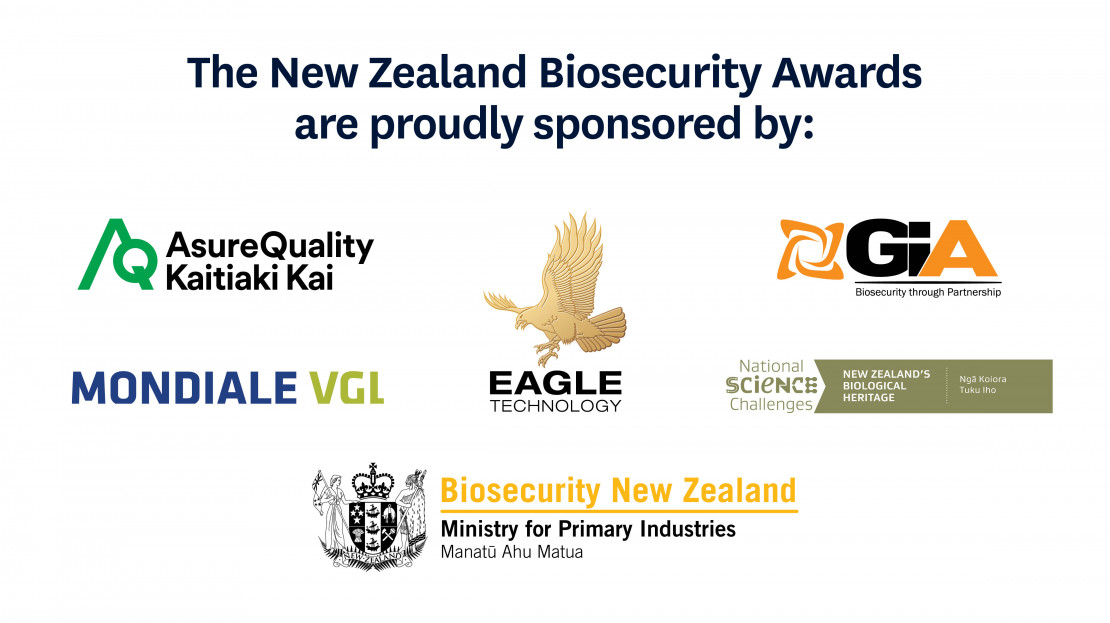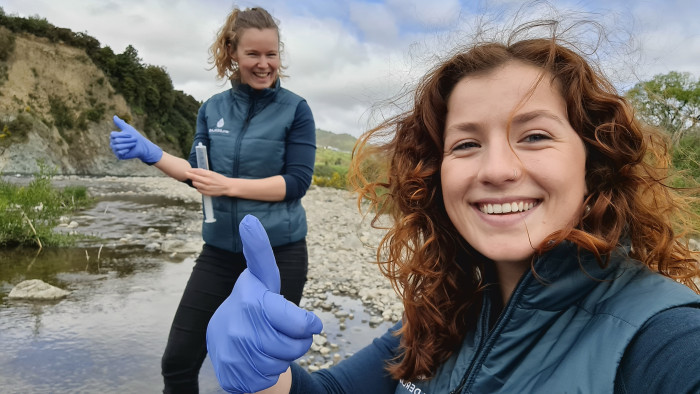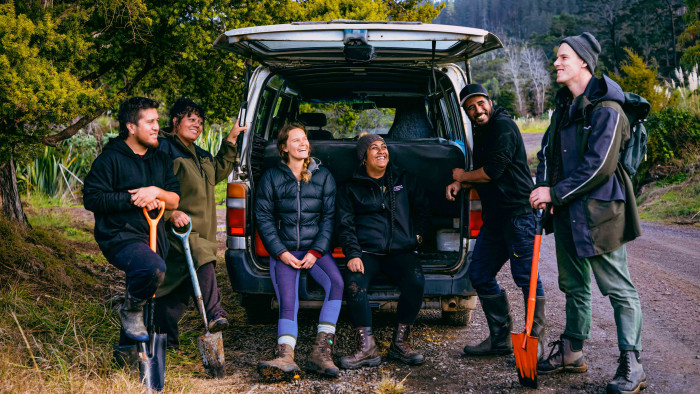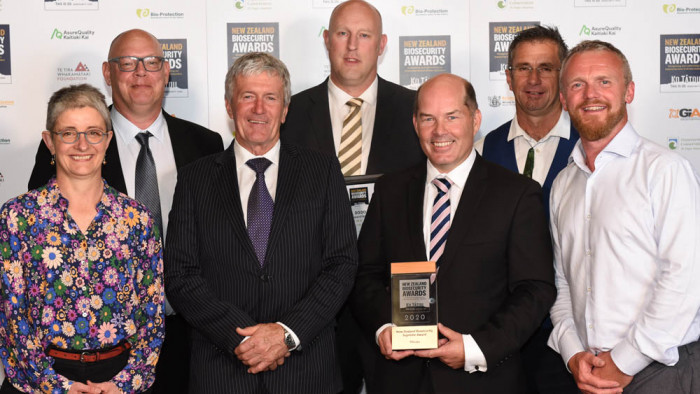2024 Biosecurity Awards finalists and winners
2024 New Zealand Biosecurity Awards Winners
We are delighted to announce the Biosecurity Awards winners for 2024!
Minister's Biosecurity Award
Winner: Dr Brian Richardson - Scion
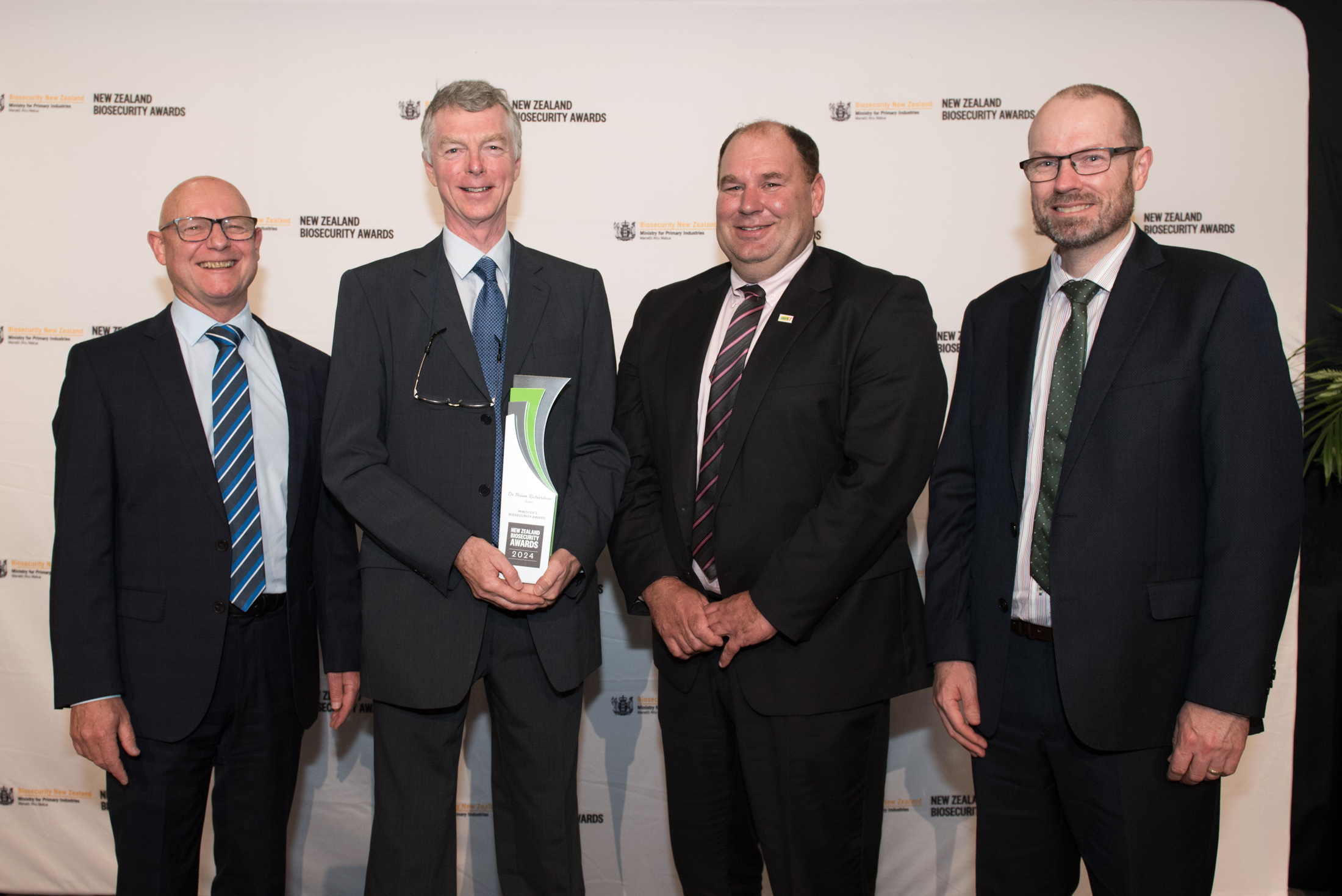
Hon Andrew Hoggard Minister for Biosecurity Ray Smith Director General and Stuart Anderson Deputy Director General BNZ with Ministers Biosecurity Award winner Dr Brian Richardson
As Principal Scientist at Scion, Dr Brian Richardson has championed forest protection over nearly four decades. During this time, he has made significant contributions to New Zealand’s biosecurity responses, weed science and research relating to aerial pesticide applications.
Brian is an internationally recognised expert in forest vegetation management. His expertise in pesticide application has been applied to wilding conifers, where he helped to generate guidelines for effective aerial spraying for their eradication. These guidelines now underpin the Wilding Conifer Control Programme.
He has contributed to technical advisory groups convened to address significant biosecurity incursions from pests, such as the brown marmorated stink bug and painted apple moth.
Through his leadership and involvement in various sector-wide forest biosecurity initiatives Brian has served, most notably on the Forest Biosecurity Council and also served as a board member on many research programmes, including Better Border Biosecurity, BioProtection Research Centre, and Frontline Biosecurity.
Through his lifelong contributions, Brian is passionate about the role science can play in protecting New Zealand’s flora.
New Zealand Biosecurity Supreme Award
Winner: Ngā Hāpu o Te Rāwhiti, Ngāti Kuta rāua Ko Patukeha - R.E.P NZ
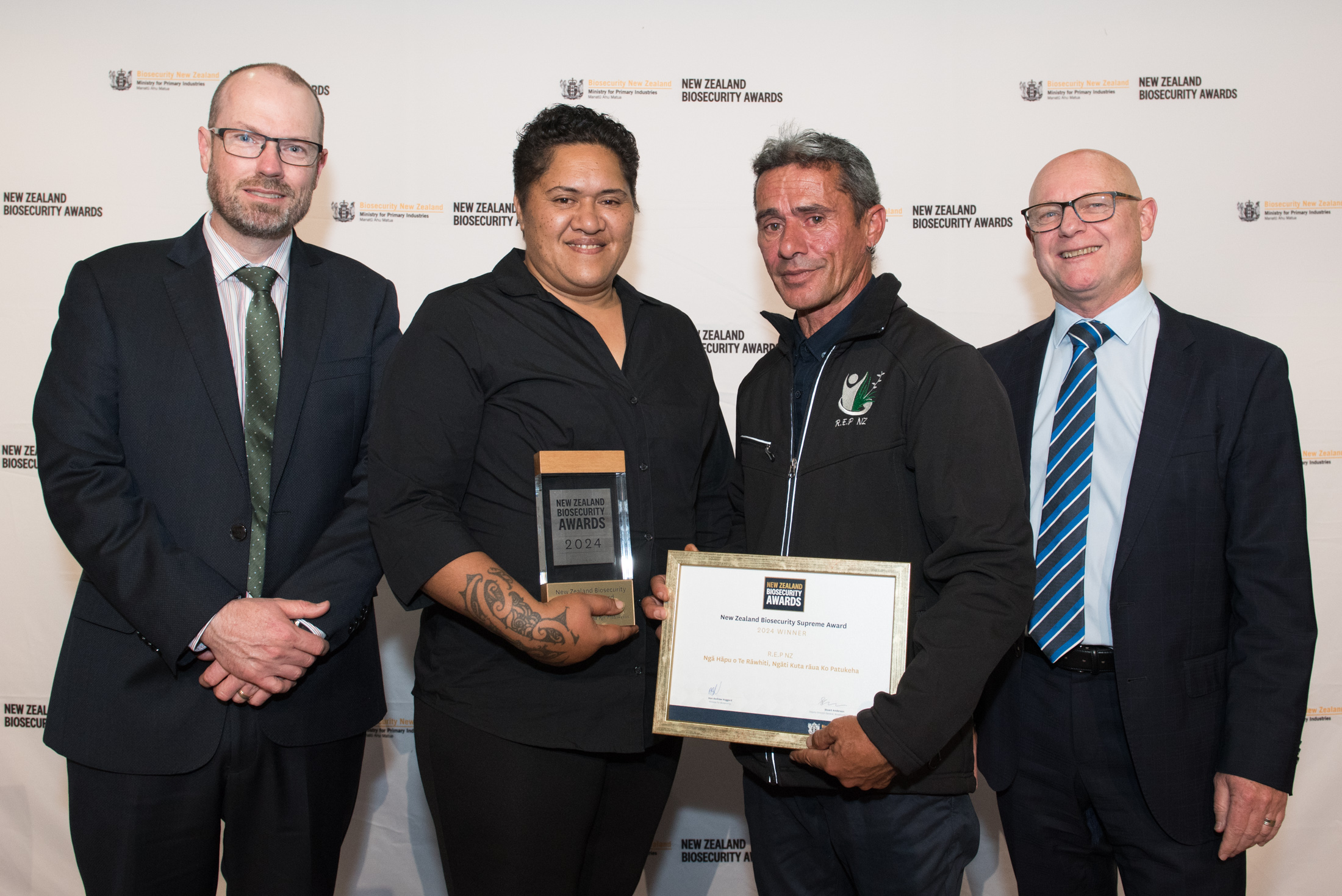
Discovering exotic Caulerpa seaweed in Te Rāwhiti and taking a key role in the community’s response, helping reintroduce native birds in offshore islands, and a decade of pest eradication on Ipipiri are among the many ways Viki Heta and Arana Rewha are working tirelessly to protect their rohe in the Bay of Islands.
This dynamic duo are a true embodiment of biosecurity champions in Te Tai Tokerau. Rana has earned the titles ‘guardian of the sea’ and ‘reluctant hero’ through his leadership in the Caulerpa response. With his in-depth knowledge of local ocean currents and hydrology, he provided insight to areas where the seaweed may spread in the area. Vicki is leading hui to ensure the hapū and Russell community remain up to date with the response to the exotic pest.
Among their many achievements, Rana and Vicki have been championing the eradication of Sika deer in Russell Forest and Ngaiotonga Scenic Reserve, leading to a 20-year forest health plan to restore the health and biodiversity of the area. Their understanding of the interconnectedness of Ki Uta Ki tai (the whole environment) is shown in their dedication and commitment to biosecurity across whenua and moana, bringing people together through their passion, drive and commitment to Te Rawhiti taiao.
With their ongoing work, Rana and Vicki have successfully helped biodiversity flourish, bird song return, fauna and flora grow. They are helping restore and heal the whenua one project at a time for their rohe to enjoy for generations to come.
BioHeritage Challenge Community Award
Winner: Ōkārito GorseBusters Charitable Trust – Ōkārito GorseBusters
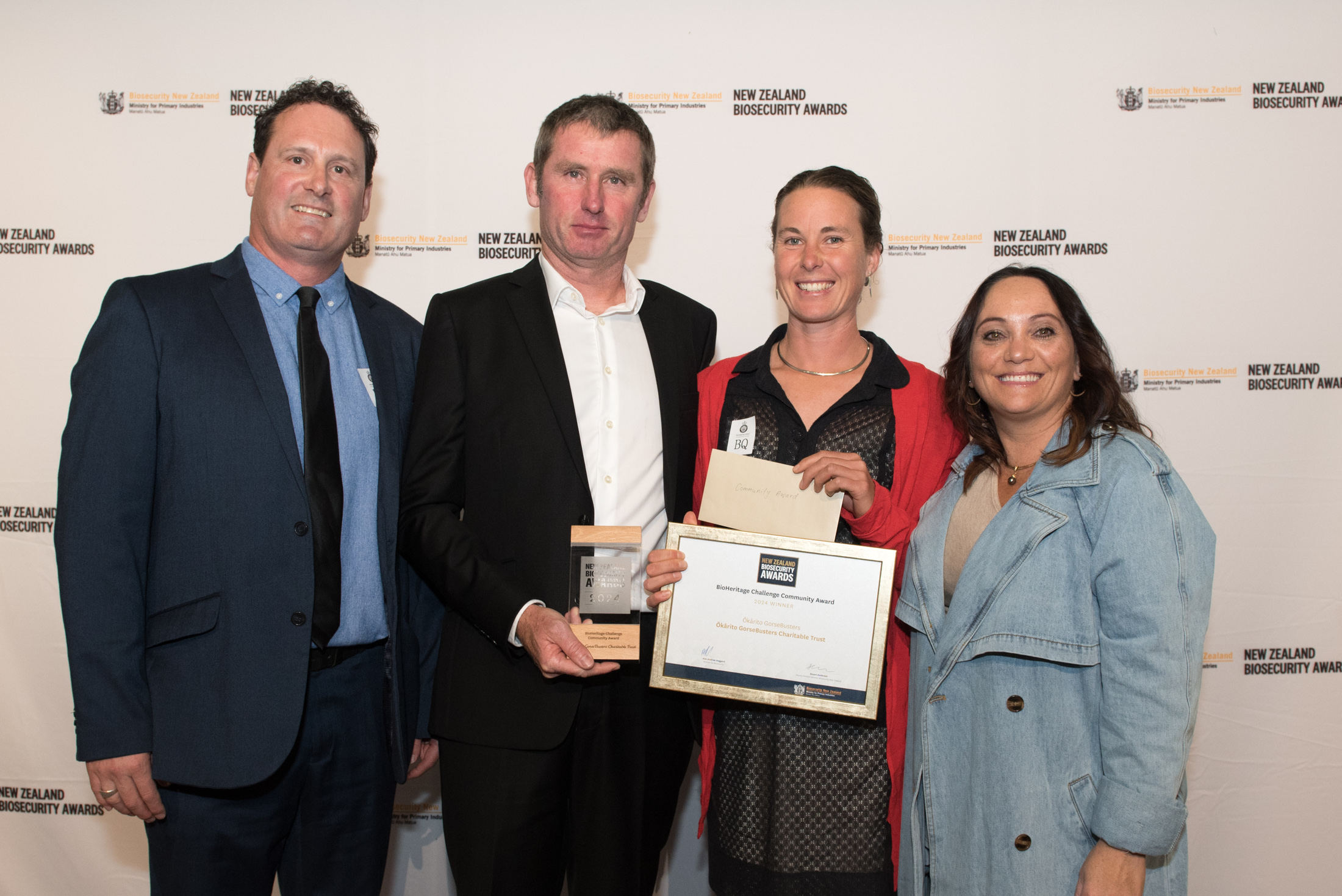
Daniel Patrick and Melanie Mark Shadbolt with the BioHeritage Challenge Community Award winner Okarito GorseBusters Charitable Trust
Inspirational, community-led Ōkārito GorseBusters Charitable Trust is leading the way in protecting the habitat of Ōkārito Lagoon – New Zealand’s largest unmodified coastal wetland and a UNESCO World Heritage site.
The work of GorseBusters to protect, preserve, and restore bird nesting and whitebait spawning habitats under threat from gorse invasion in the lagoon has become a passion for many, with volunteers arriving from as far away as Auckland (and even from overseas!).
With the phenomenal effort from the community, and support and blessing of mana whenua, the tiny West Coast community of 40 permanent residents has hosted over 1,200 volunteer days in the past three years. Their work has succeeded in controlling gorse over 40 kilometres of shoreline, improving the habitat for whitebait breeding, matuku (Australasian bittern) and kōtuku (white heron).
Through the incredible generosity of the community to biosecurity and biodiversity values, this special place will continue to be some of the best wetland in New Zealand – and the world.
Finalist: Banks Peninsula Conservation Trust – Feral Goat Eradication
Aspiring to achieve a pest-free Banks Peninsula by 2050, the Banks Peninsula Conservation Trust is making outstanding progress towards achieving this goal through its feral goat eradication programme.
Lead by the Trust, the Banks Peninsula Feral Goat Eradication Programme is a community biosecurity success story, eradicating feral goats from the peninsula and demonstrating the power of collaboration between local landowners, skilled contractors, and underpinned with strong support from the Department of Conservation, Environment Canterbury, and Christchurch City Council. Since 2018, more than 4,200 feral goats have been removed across 42,500 hectares, with the support of 316 private landowners. Encouraging a true team effort, this commitment has ensured the unique environment is no longer under threat from these pests.
The success of the Trust’s work means learnings are now being applied to other significant pest removal operations on Bank Peninsula. The Trust works with landowners, agencies, rūnanga, sponsors, and the wider community to promote the protection and enhancement of biodiversity and sustainable land management on the peninsula.
Finalist: Tākaka Hill Biodiversity Group Trust – Restoring and Protecting Tākaka Hill Ecosystems
Recognising their role as kaitiakitanga, landowners formed the Tākaka Hill Biodiversity Group Trust in 2018. With a holistic approach to ecosystem restoration and protection, and a 50-year strategy, the trust is safeguarding the biodiversity and biosecurity of land on Tākaka Hill.
This area is significant due to its limestone geology and native flora, and as a corridor linking Abel Tasman and Kahurangi national parks.
Through the work of these passionate locals, notable achievements to date include control of pest plants, such as wilding pines; native plant propagation; extensive predator trapping, using over 400 traps; restoration planting; and assisting scientific research and data collection on endangered and indicator species.
The empowering work of the trust has successfully mobilised the community to join its work in protecting and strengthening biosecurity in New Zealand.
Te Uru Kahika Māori Award
Winner: Ngā Hāpu o Te Rāwhiti, Ngāti Kuta rāua Ko Patukeha - R.E.P NZ
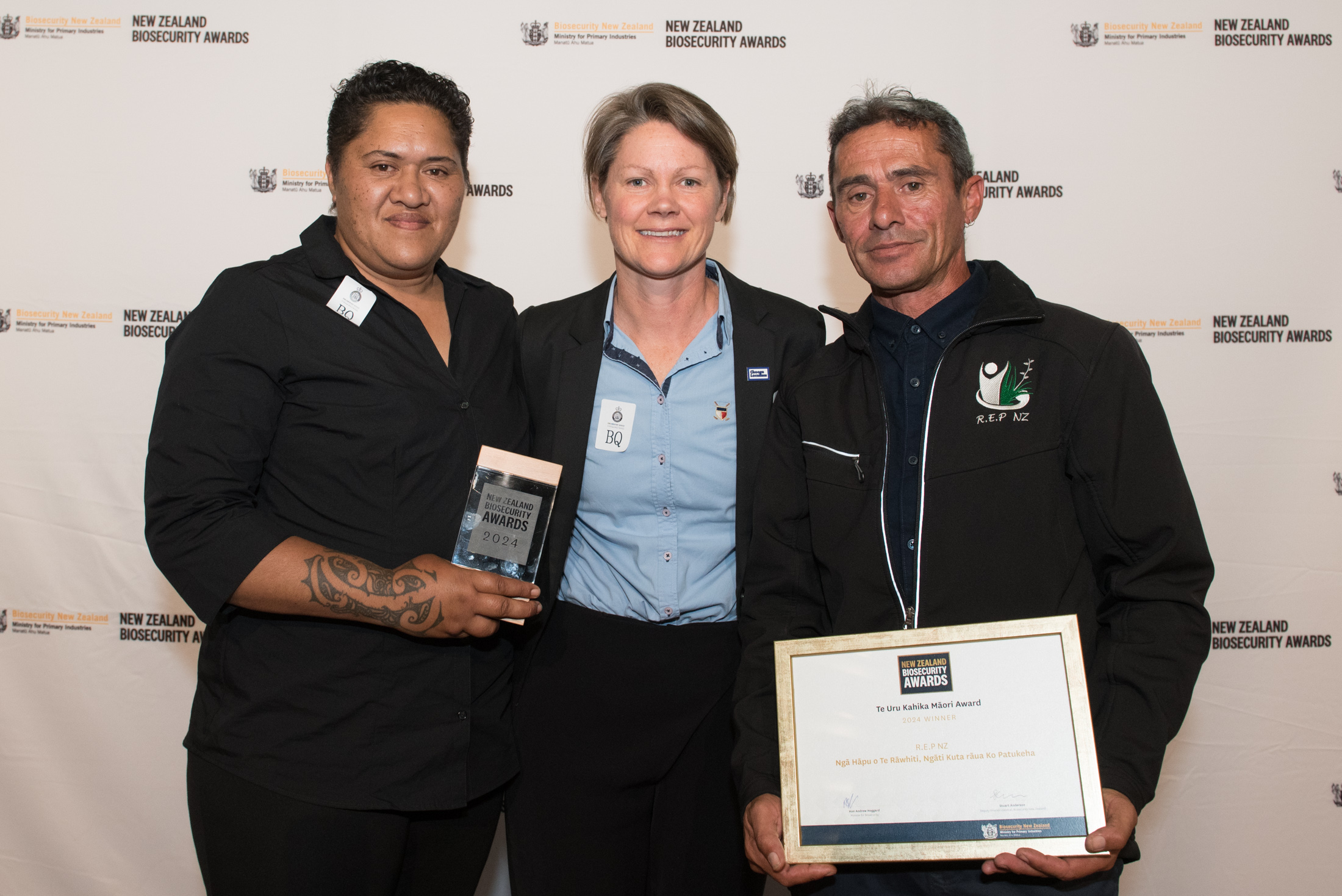
Discovering exotic Caulerpa seaweed in Te Rāwhiti and taking a key role in the community’s response, helping reintroduce native birds in offshore islands, and a decade of pest eradication on Ipipiri are among the many ways Viki Heta and Arana Rewha are working tirelessly to protect their rohe in the Bay of Islands.
This dynamic duo are a true embodiment of biosecurity champions in Te Tai Tokerau. Rana has earned the titles ‘guardian of the sea’ and ‘reluctant hero’ through his leadership in the Caulerpa response. With his in-depth knowledge of local ocean currents and hydrology, he provided insight to areas where the seaweed may spread in the area. Vicki is leading hui to ensure the hapū and Russell community remain up to date with the response to the exotic pest.
Among their many achievements, Rana and Vicki have been championing the eradication of Sika deer in Russell Forest and Ngaiotonga Scenic Reserve, leading to a 20-year forest health plan to restore the health and biodiversity of the area. Their understanding of the interconnectedness of Ki Uta Ki tai (the whole environment) is shown in their dedication and commitment to biosecurity across whenua and moana, bringing people together through their passion, drive and commitment to Te Rawhiti taiao.
With their ongoing work, Rana and Vicki have successfully helped biodiversity flourish, bird song return, fauna and flora grow. They are helping restore and heal the whenua one project at a time for their rohe to enjoy for generations to come.
Finalist: Aki Tai Here - Aki Tai Here
Aki Tai Here is creating space for the regeneration of taonga fauna and flora through strategic pest control. This mahi is benefiting Northland’s environment by protecting the biodiversity of forests in the Whangarei Heads area and helping to restore and sustain the mauri and mana of the whenua (land).
Mana whenua-led kaitiakitanga (guardianship) is at the centre of all operations, integrating respect for Māori knowledge and values.
At the heart of Aki Tai Here mahi is inter-generational connectedness and kaitiakitanga for the whenua that their tūpuna (ancestors) have cared for and their mokopuna (grandchildren) will care for in years to come.
Through sharing knowledge, skills and resources, Aki Tai Here are empowering wider whanau and hapū to get involved. The group has contributed thousands of hours across various projects from Pataua, to Manaia to Parua Bay, providing paid employment and helping strengthen relationships between tangata whenua and the environment.
Finalist: Te Whakahononga
Saving kauri and myrtles from two devastating pathogens, Te Whakahonoga, is a partnership between eleven mana whenua research teams and Western scientists working to address the impact of phytopthera agathadicda (PA) and myrtle rust (MR) on taonga.
Recognising outstanding biosecurity achievements, Te Whakahononga is based on an authentic empowerment of mana whenua and their communities through strong investment in Māori-centred research which informed both Mātauranga Māori-derived solutions and Western-based research aimed at enhancing native biodiversity resilience and protecting ttaonga from plant pathogens.
The mana whenua from eleven Biodiversity Management Areas worked with western scientists to better understand the pathogens, and applying both western science and matauranga Maori informed solutions for biosecurity surveillance and monitoring and also solutions to protect taonga kauri and native myrtles. Novel technologies and approaches were adopted by mana whenua, who used their intergenerational knowledge of taonga and ngahere, were trained to deploy and test using both western science and matauranga solutions to improve surveillance and monitoring of PA and myrtle rust. The knowledge gained through Te Whakahononoga informs a wealth of knowledge to combat biosecurity threats and incursions. Mana whenua involved in Te Whakahononga have embraced the opportunities provided to them, undertaking bespoke research projects that have been used to advance and contribute towards the national effort to combat kauri dieback and myrtle rust.
A Te Tiriti centric approach, Te Whakakhononga has advanced the protection and survival of taonga species as well as building a successful framework and elevating Māori capability across Aotearoa science and biosecurity systems, transforming the way Mātauranga Māori and Western science partner together both now and for generations to come.
New Zealand Biosecurity Kura (School) Award
Winner: Maeroa Intermediate School – Maeroa Intermediate Gully Restoration Project
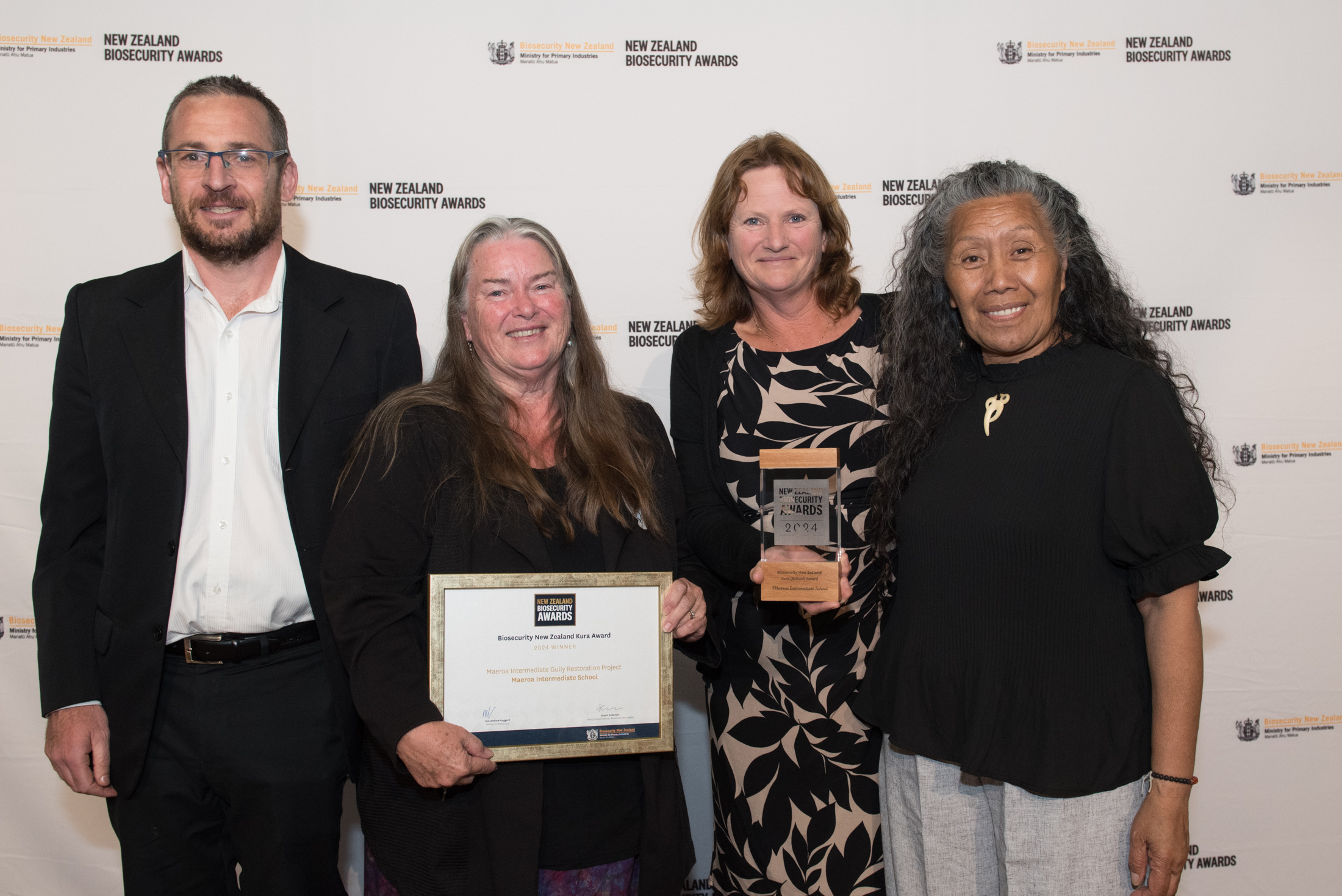
A 0.5-hectare gully at Maeroa Intermediate School had been neglected for decades. It had become a dumping ground for rubbish and a breeding ground for pest weeds and animals and was out of bounds to students.
To rectify the situation, the school set up the Maeroa Intermediate Gully Restoration Programme in 2020. After consultation with local experts and the school community, the gully restoration vision and action plan were established, with the initial clearing and planting phase expected to take 12 years.
Since the project began, the students, whānau and local community have cleared weeds and rubbish, grown over 4,000 eco-sourced plants, replanted native trees, and created a lizard habitat and outdoor classroom.
The students are passionate about their outdoor classroom and take visitors on gully tours, showing first-hand the differences they have made to protect their community from unwanted pests and diseases.
Finalist: Waitaria Bay School – Pest Free Playground
One of New Zealand’s most inland isolated schools, Waitaria Bay School in the heart of Marlborough is leading the way in teaching students how to bring native plant and animal species back into their playground.
As part of the Pest-Free Playground Project, students have built, run, and monitored possum and rat traps around the school and the local vicinity over the past five years and entering the data with Trap NZ.
Waitaria Bay School are encouraging a true team effort of biosecurity champions. They have minimised the number of predators in their playground, set up lizard habitats and established wasp bait stations to support the bee population, while also regularly travelling to Manaroa to clean a section of the coastline, as part of the Sustainable Coastlines initiative. Also, they established the 'Kereru Kitchen' to encourage local bird life.
The actions of the students at Waitaria Bay School have truly made a tangible difference in protecting their community from unwanted pests and diseases.
Finalist: Western Springs College – Ngā Puna o Waiōrea – Waitītiko Awa Restoration
Tautiakitanga (sustainability) is one of the core values at Western Springs College - Ngā Puna o Waiōrea. Student lead groups, the Kaitiakitanga rōpū, the Trapping group and Wastewise drive sustainability activities to restore biodiversity and biosecurity in their community.
For 12 years, students have been removing invasive weeds and planting native species along Waitītiko awa (Meola Creek) – a bush area connecting the school to the Western Springs Park and Auckland Zoo, including the critically endangered lava rock forest.
In the past 2 years, the inspiring work of students has continued to grow to include planting and maintaining a pā harakeke, establishing and maintaining possum and rodent traps, and gaining the knowledge they need to care for the awa.
Through these projects, Western Springs College - Ngā Puna o Waiōrea is engaging and upskilling lifelong biosecurity kaitiaki (guardians of the land).
GIA Industry Award
Winner: VeritAg – Bringing the Private Sector into the M. bovis Programme
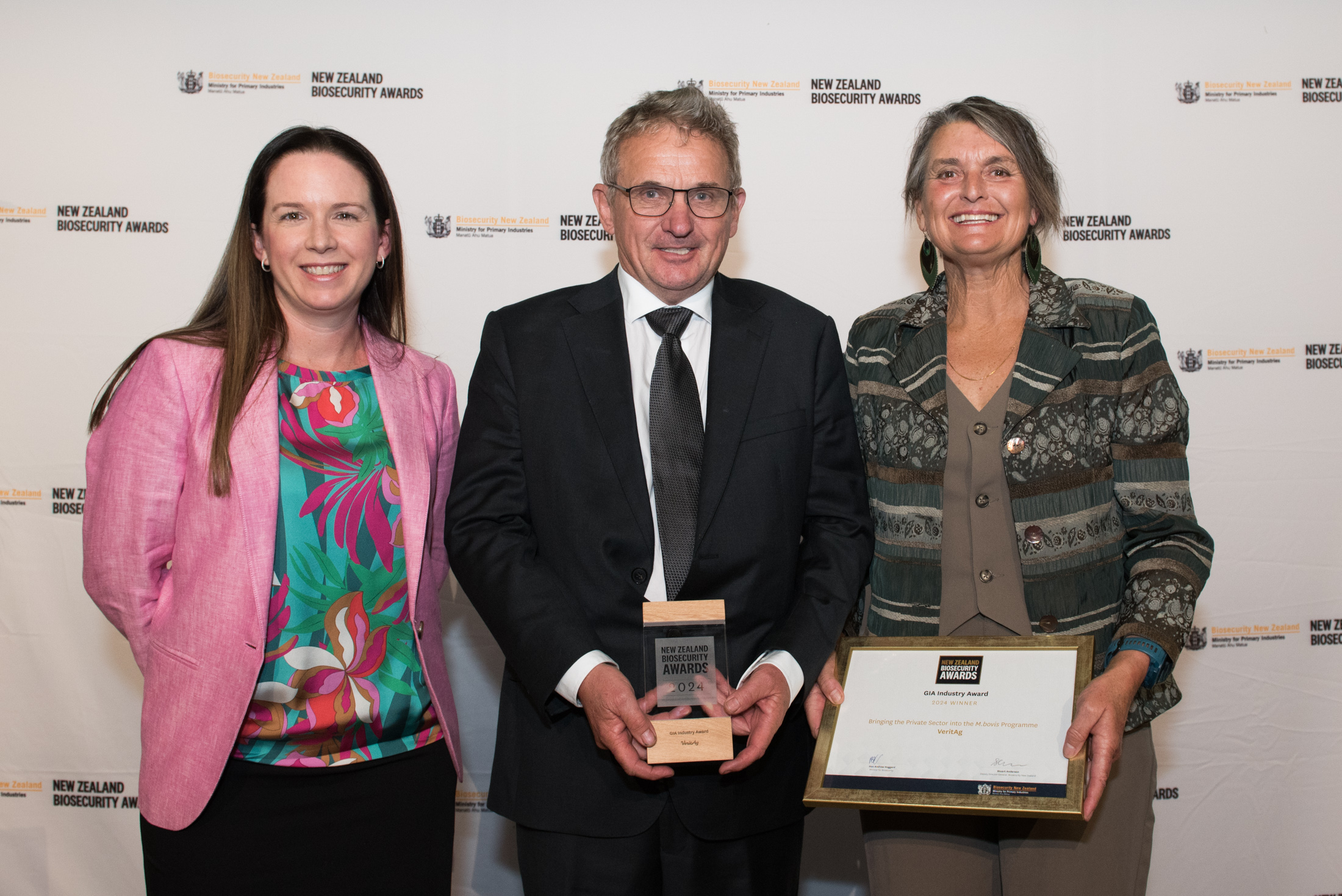
Encouraging a true team of biosecurity champions, VeritAg and their collaborating partner, SVS Labs, facilitated the deployment of 220 veterinary practices to support Biosecurity New Zealand’s Mycoplasma bovis (M. bovis) Eradication Programme.
The introduction of private veterinary practices brought significant testing capacity to the M. bovis programme, reducing the time farms spent under restriction. Committed to protecting our biosecurity system, VeritAg often worked on urgent cases outside of normal business hours to ensure biosecurity goals were met.
This work has helped lessen the impact of M. bovis on farmers, and deepened and enhanced relationships between private veterinarians and the M. bovis programme. This has assisted in the success of the on-going biosecurity eradication response so far.
Finalist: Aquaculture New Zealand – A+ Biosecurity Standards
Enabling marine farmers to be at the forefront of protecting New Zealand’s waters, Aquaculture New Zealand has collaborated with industry experts and marine farmers to develop the A+ Biosecurity Standards, contributing to New Zealand’s aquatic biosecurity system.
The standards provide a consistent and transparent approach to manage and reduce biosecurity risk in the aquaculture industry by guiding the development of biosecurity management plans. Aquaculture New Zealand collaborated with vets, biosecurity experts and industry representatives to ensure the standards provide practical, cost-effective risk management.
Through the development of these standards, Aquaculture New Zealand is contributing to a national approach to aquatic biosecurity, ensuring all New Zealander’s can enjoy our country’s beautiful marine resources now and into the future.
Finalist: Sails for Science NZ – Northland Students United in Marine Pest Detection
Sails for Science NZ is on a mission to make biosecurity come alive for Northland college students through hands-on learning experiences, providing them with the tools and knowledge to help safeguard our marine environments from invasive species.
Collaborating with regional councils, scientific institutions and iwi to bring science out of the lab, Sails for Science NZ has achieved significant milestones in the Bay of Islands, Whangarei and Whangaroa.
This year, Sails for Science NZ has introduced 300 students to biodiversity, biosecurity, the risk of invasive species, environmental DNA (eDNA), environmental monitoring and management from a Te Ao Māori worldview.
Through their incredible work and commitment, Sails for Science NZ is promoting awareness and understanding of biosecurity in the unique marine biodiversity of Aotearoa New Zealand and empowering the next generation of kaitiaki (guardians).
Eagle Technology Local and Central Government Award
Winner: Waikato Regional Council - Kauri Protection Programme
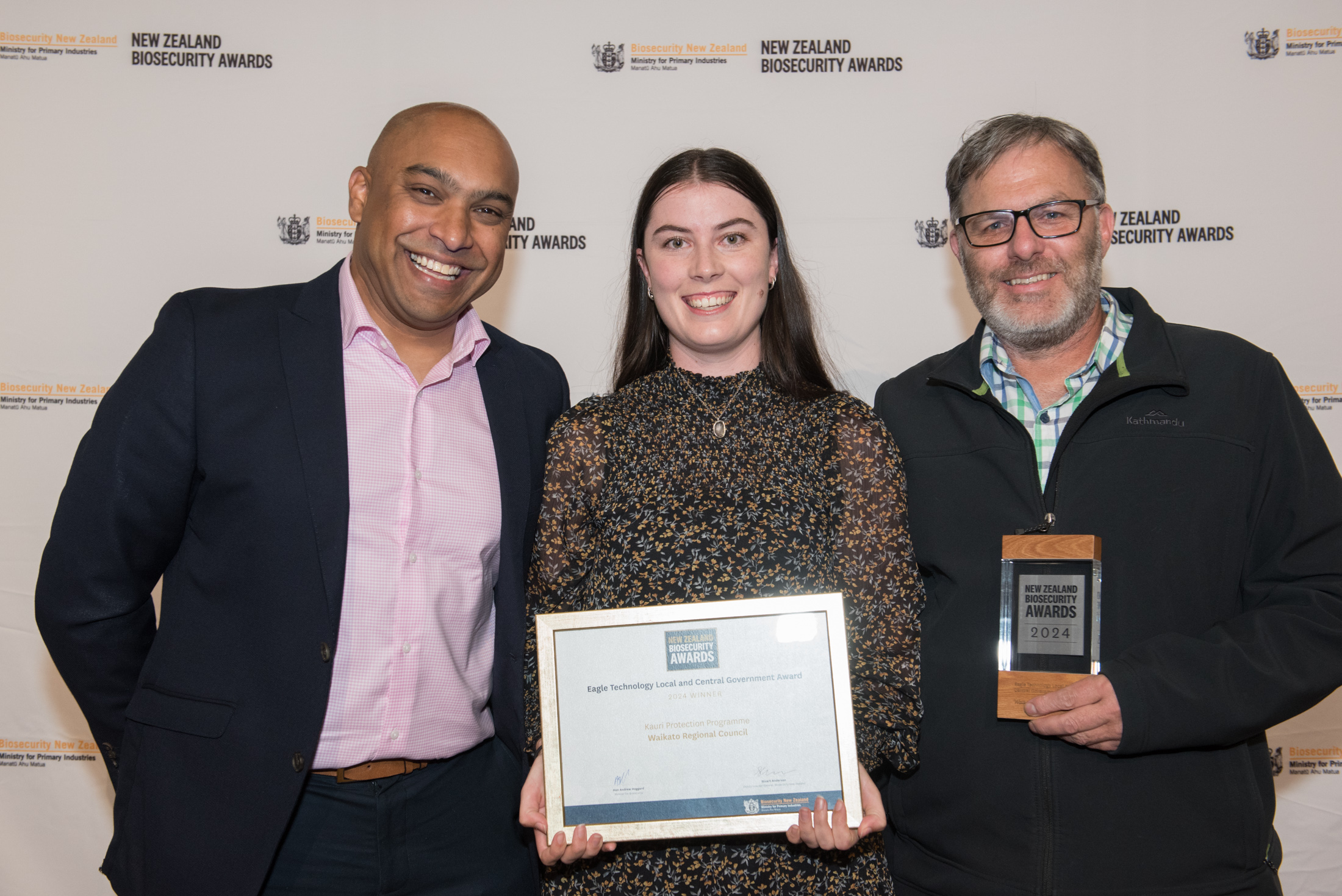
‘Southern’ kauri forests are vital to the future of kauri, being predominantly free from kauri disease. For this reason, Waikato Regional Council has ramped up its kauri protection programme, with the aim to inspire and enable rural landowners, community groups, schools, iwi, stakeholders and industry groups to invest in a future that includes healthy kauri forests with giant kauri.
A small Kauri Protection Team promotes and advocates for the ecologically unique southern kauri through science and research, marketing and communications, education and advocacy, and on-the-ground works on private land.
Highlights include the creation of a Wētā Workshop kauri tree model, a visual representation of a mature, healthy ancient kauri and the extent of its vulnerable root system; a kauri virtual reality experience that focuses on the cultural, spiritual and ecological significance of kauri to inspire behaviour change; providing cleaning stations, hygiene kits and equipment to community volunteer groups and businesses that work within or inspire visitors to enter kauri forests; and providing funding of up to 100 per cent to private landowners for fencing to keep stock out of kauri areas.
The work being done is supported by research specific to the region, for example, kauri mapping, stock accessibility.
Finalist: AsureQuality - Blackgrass Response 2022-2023
The AsureQuality team has been contributing to the biosecurity black grass response, led by Biosecurity New Zealand. Black grass poses a serious risk to New Zealand’s environment and to the arable industry, with potential economic impacts.
When blackgrass was identified in linseed crops in the Canterbury region in December 2021, a swift biosecurity response was critical to prevent black grass from becoming established here. Biosecurity New Zealand engaged AsureQuality, a state-owned enterprise and provider of biosecurity services, to assist in the response. This initially involved the AsureQuality team removing immature Blackgrass plants from crops and the cutting, baling, wrapping and transport of the risk material for destructive treatment by air curtain incineration.
Following a subsequent find in a wheat crop in 2022, AsureQuality was again involved, surveying and rouging affected crops to remove Blackgrass and helping with tracing and the identification of additional contaminated lines and at-risk properties in Canterbury. AsureQuality also oversaw the bailing, cutting, and wrapping of more than 3,200 bales from risk properties., Novel techniques were employed to reduce the risk of seed dispersal. Including the use of a low emission burning process for destruction of these bales as an alternative to burial and to remove the risk of Black grass establishment from a significant cropping area in Canterbury.
The successful response demonstrates the agility of an engaged community and truly highlights the power of positive relationships across local and central government, the grain and seed industry, and agricultural contractors and the farming community.
Finalist: NIWA, the National Institute of Water and Atmospheric Research - Caulerpa Biosecurity Response Team
Since the discovery of the invasive seaweed exotic Caulerpa at Aotea Great Barrer Island in 2021, the National Institute of Water and Atmospheric Research (NIWA) team has delivered the laboratory and field components of Biosecurity New Zealand’s response.
With biosecurity at the forefront, and in partnership with mana whenua, NIWA has provided specialist scientific advice and undertaken surveys in a challenging underwater environment. It has also helped trial suction dredging, salt treatment, and manual removal of Caulerpa by divers.
The NIWA dive team collectively swam 32km of transects and searched over 55,000m2 of seafloor, after Caulerpa was found in the Bay of Islands this year.
Through strong leadership and commitment to protecting New Zealand’s unique aquatic environment, NIWA has developed innovative practices and tools, demonstrating technical competence and professionalism in the Caulerpa response – and all under the constraints imposed by Covid-19 and Level 4 Lockdown.
New Zealand Biosecurity Science Award
Winner: Cawthron Institute - Marine Biosecurity Toolbox Research Programme
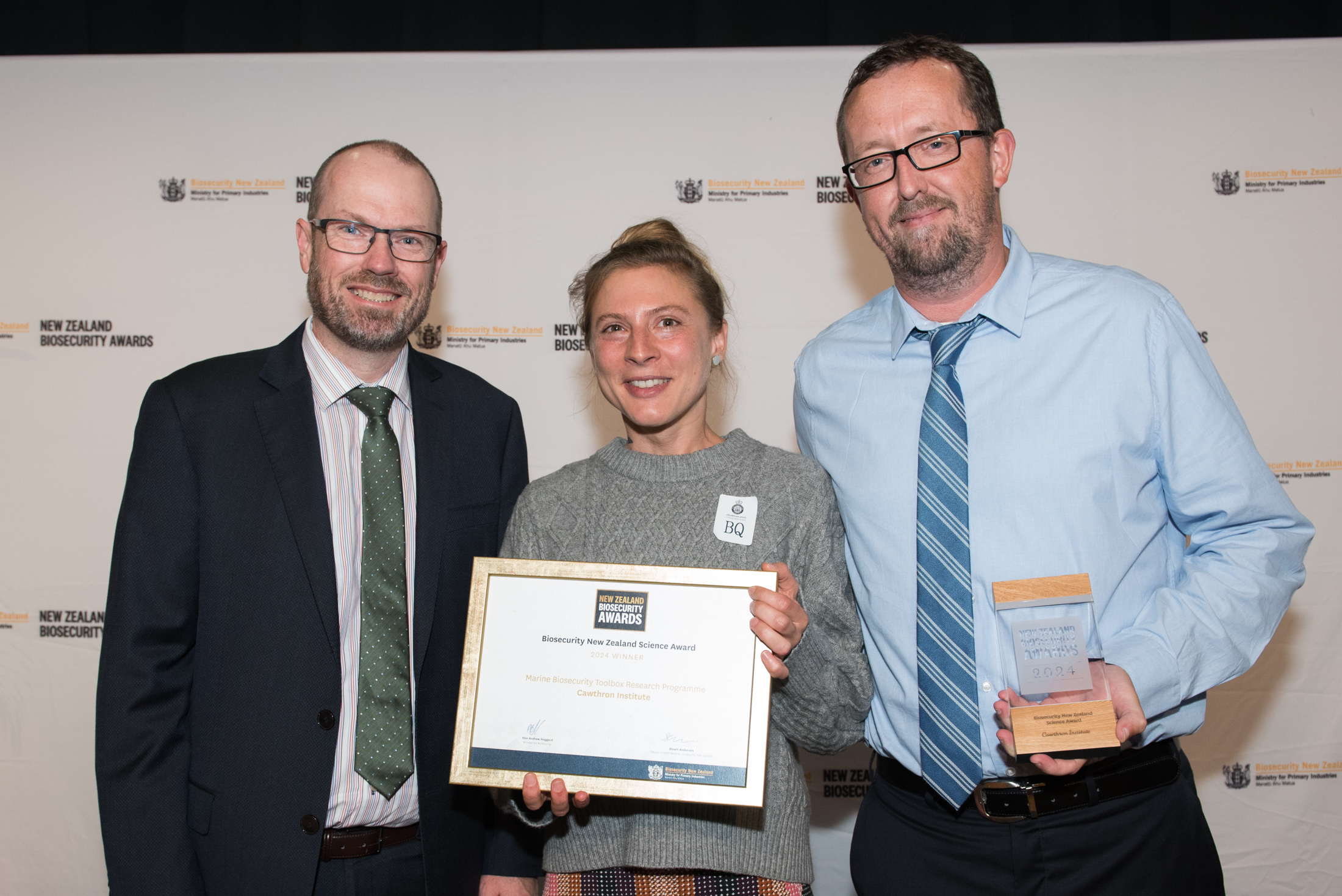
New Zealand’s largest marine biosecurity research programme, Marine Biosecurity Toolbox Research Programme has transformed the detection and elimination of invasive marine pests through molecular surveillance technology and analytical platforms. The five-year programme is focused on protecting New Zealand’s marine environments from the impacts of non-indigenous species by developing transformative tools that empower regulators, industry, mana whenua, and the community to effectively manage risk pathways, prevent pest establishment, and detect and respond to new incursions.
The range of tools allow for timely detection to disrupt critical stages of the invasion process through specialised water sampling linking to an app for automated alert systems that enhance the delivery of a robust marine biosecurity system.
Rapid, cheap and effective molecular sampling tools, analytical platforms and protocols have dramatically improved New Zealands ability to detect and monitor marine pests.
Through its work, the programme is fostering a new generation of biosecurity scientists, working in collaboration with Māori-led research for implementing mātauranga Māori and science collaboration for biosecurity outcomes.
Finalist: Ngā Rākau Taketake – Saving our Iconic Trees from Kauri Dieback and Myrtle Rust
Two unwanted pathogens, kauri dieback and myrtle rust, are impacting on our unique ngahere , one of the longest-living tree species in the world, kauri, and evergreen trees and shrubs of the myrtle family, including iconic native species such as pōhutukawa, mānuka, kānuka, rātā, swamp maire and ramarama.
Ngā Rākau Taketake is a multidisciplinary programme of researchers, mana whenua, agencies, and communities working together to save these iconic taonga.
This collaborative approach, across disciplines and communities, uses matauranga-based research to develop long-term management strategies through tikanga-driven conservation initiatives in the battle against the pathogens that cause kauri dieback and myrtle rust. This approach recognises that protecting these native taonga species means protecting our intricate and inter-connected ecosystems, cultural relationships and national identity.
The teams are generating new knowledge and tools in the fight against these pathogens, including the development a world-first chromosome-level genome for the phytophthora pathogen, which is being used in further research to determine how the pathogen seeks and binds to its hosts, and causes ‘kauri dieback disease’.
Finalist: AgResearch – The AgResearch Animal Health Solutions Team
Committed to progressing the biosecurity of the farmed animals sector, the team at AgReseach Animal Health Solutions are developing diagnostic tools for identification of disease outbreaks, as well as monitoring systems for reporting and managing disease incursions.
Accurate and cost-effective tools enable rapid detection of diseases, minimizing trade risks and saving millions of dollars. The recent focus has been on initiatives advancing Bovine tuberculosis diagnostics, Johne’s disease and vaccine development; Mycoplasma Bovis diagnostic research; and use of MicroRNA profiling as biomarkers for diagnosing the severity of infection, which has significantly advanced biosecurity for the farmed animal sector.
The AgResearch Animal Health Solutions team are committed to ensuring their ongoing implementation of new initiatives continues to improve the delivery of effective biosecurity associated with Animal disease in New Zealand.
Mondiale VGL Innovation Award
Winner: EcoNet Charitable Trust – The innovative EcoNet CAMS Weeds toolkit
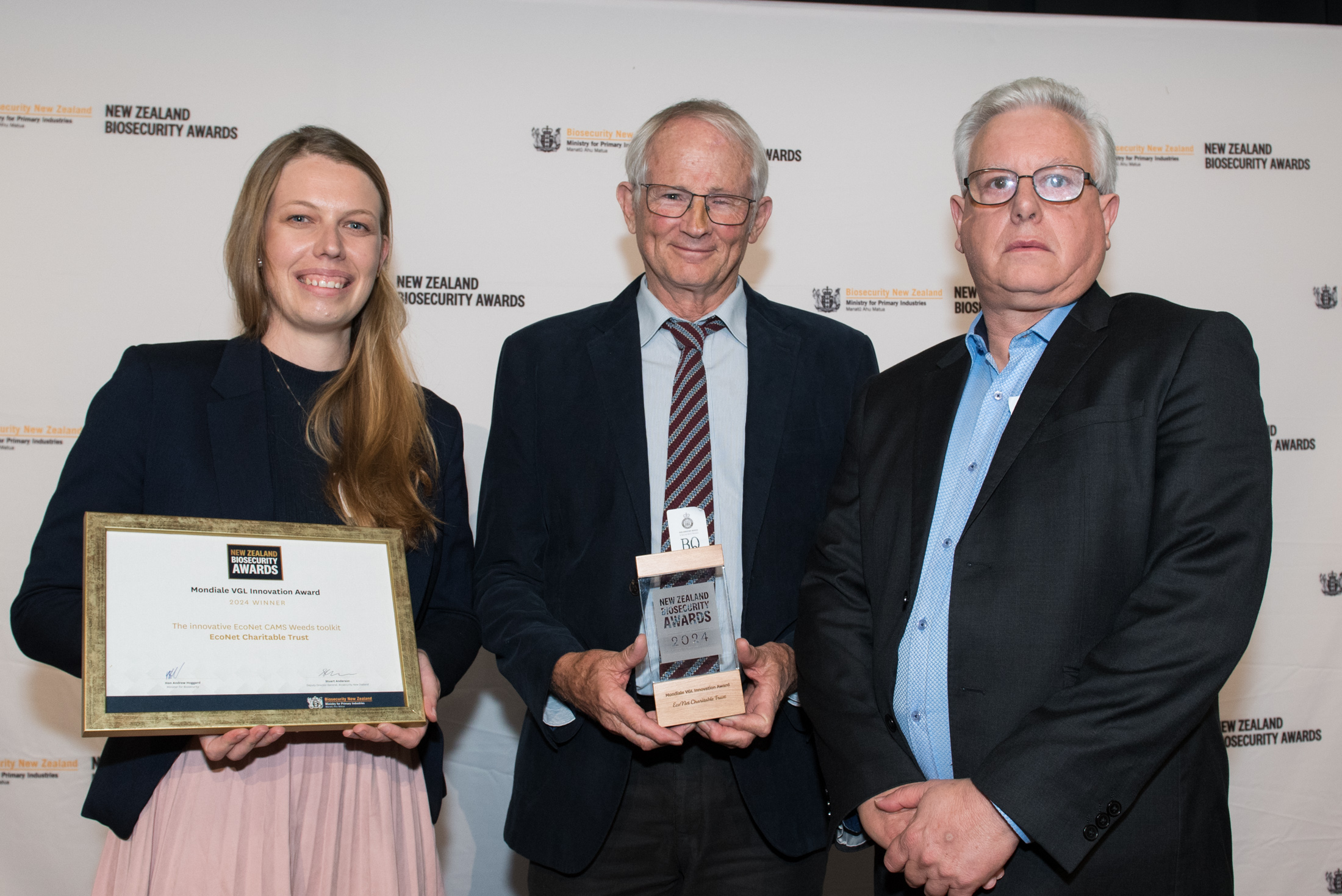
Empowering conservation groups is at the heart of the EcoNet Conservation Activity Management System (CAMS) project. An initiative of the EcoNet Charitable Trust, EcoNet CAMS is designed to foster collaboration in conservation across communities and regions by providing a suite of customer relationship management (CRM) and GIS tools.
Designed by experts in consultation with community groups, EcoNet CAMS enables communications and data sharing to foster innovation and improved pest management practices for volunteers, neighbourhood groups, iwi and communities.
The CAMS Weeds toolkit is a Geographic Information System (GIS) that was introduced to address the growing biosecurity threat of invasive weeds across Aotearoa New Zealand. The tool allows information about weeds and weed control to be recorded and shared. It has already had a significant impact for volunteers, solving data sharing problems and inspiring people to collaborate and share the results of their biosecurity work with others.
Finalist: Auckland Council – Ruru Conservation Information System
The most comprehensive biosecurity and biodiversity database currently in New Zealand, Ruru Conservation Information System was developed by Auckland Council’s Environmental Services department to centralises conservation information across the organisation.
Ruru contains about 80 datasets relating to pest plant and animal control, kauri dieback, native species and ecosystem management, restoration planting, regional pest management, community and engagement. As at the end of 2023 Ruru holds data for 78,000 pest traps, 63,700 kauri surveillance points, and three million plants across 5,550 planting areas.
Ruru has transformed the way the Environmental Services manages protection of the natural environment for generations to come. It is enabling regional knowledge sharing and collaboration with other organisations, partner agencies, community groups, and national biosecurity programmes, ensuring informed decision-making to achieve environmental objectives.
Finalist: Te Ara Hīkoi – Tāwhiti Smart Cage
The Tāwhiti Smart Cage is transforming the way predator control efforts are delivered on private rural land in Franklin. Te Ara Hīkoi (Predator Free Franklin) adapted the design of a remotely monitored cage to suit New Zealand conditions, transforming the old labour intensive, low return trapping methods into a sustainable pest management option for the local community.
Combining automatic lures and sensors, the trap sends an alert via email or a phone app when it has been activated. This means users can check their whole trapline from the comfort of their kitchen table – no more walking a trapline in the pouring rain and finding no pests!
Multiple users can be linked to one account via an app on their phones, providing support to larger and neighbouring properties. Collaborative pest control efforts have increased as a result of the traps.
The smart cages are simple to use, with no previous trapping experience needed. Te Ara Hīkoi provides advice and the hardware to get local residents started with predator control programmes on their land.
AsureQuality Emerging Leader Award
Winner: Keeley Grantham – Te Arawa Lakes Trust
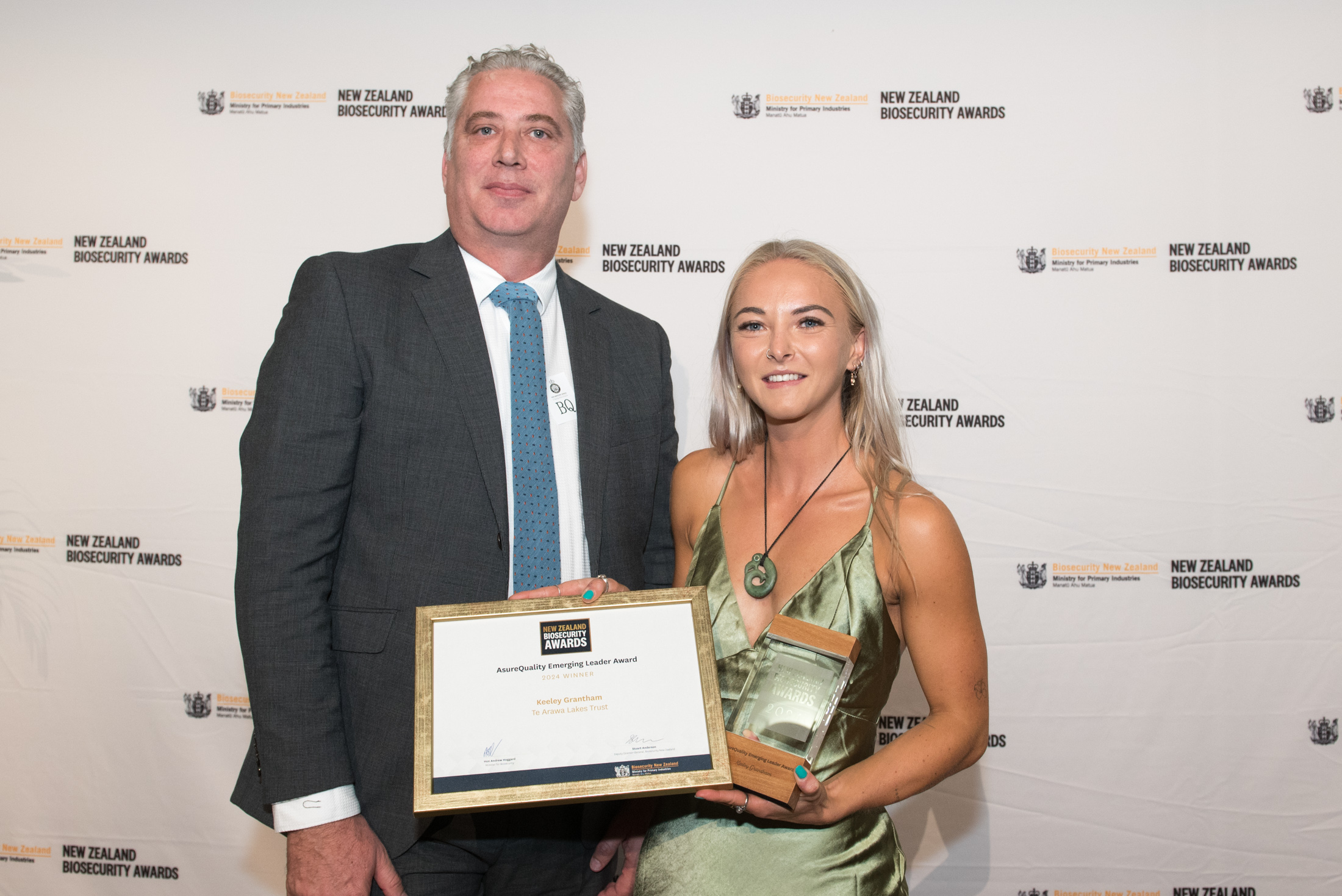
Keeley Grantham is an outstanding and passionate member of Te Arawa Lakes Trust who is going above and beyond to inspire the next generation of youth to look after the environment.
Keeley started with the trust in 2020 and began working in the catfish eradication programme a year later. She has taken the role by storm, continuing to drive the development of the Te Arawa Lakes Trust Catfish Killa programme.
Her vision and determination have led to the rapid expansion of the programme into over 36 schools in the Bay of Plenty region. Through the programme, tāmariki learn about aquatic pests and their impact on our taonga species. Recently, Keeley consolidated the teachings of the programme into a series of educational recourses and has successfully aligned these with NCEA credits to high levels of secondary education to capture a whole new generation of Catfish Killas.
Keeley’s work is not limited to the Catfish Killas. Her dedication to protect our taonga has led her to attain a New Zealand Domestic Maritime Operations Qualification, enabling her to work at the helm of the Te Arawa Lakes Trust commercial vessel, assisting with setting nets to catch and remove catfish from the hard-to-reach areas of Rotorua Te Arawa Lakes. Keeley is also the driving force behind Te Tūkohu Ngāwhā – Mātauranga Māori Science Fair – New Zealand’s only science fair dedicated to Mātauranga Māori, demonstrating her passion for education and providing opportunities for our rangatahi to thrive.
Keeley’s contribution to the community and biosecurity is outstanding, inspiring rangatahi through her engagement with kura and instilling a passion for te taiao. Embodying all the values of a kaitiaki, Keeley is an inspirational biosecurity warrior.
Finalist: Bevan Morgan
Bevan has the remarkable ability to work successfully and effectively with community-led pest control projects in Northland.
In his role as Biosecurity Officer for the Northland Regional Council, Bevan Morgan’s outstanding negotiation and communication skills have helped forge lasting partnerships between the council and communities to help safeguard biosecurity in Northland.
Known for his passion for conservation and biosecurity, and his friendly and positive attitude, Bevan manages community pest control in Te Tai Tokerau region. This work has earned him high praise from his colleagues, and the community groups and contractors he works with.
Bevan is recognised for his remarkable ability to empower community-led pest control projects in Northland, helping them achieve their goals through his empathy, listening skills and practical pest control action plans.
Encouraging, enabling and mana enhancing, he leads with humility and respect to deliver exceptional outcomes in partnership with landowner-led community groups. Bevan is an exemplary contributor to New Zealand’s, and particularly Northland, biosecurity.
Finalist: Reema Chawla
Reema Chawla‘s dedication to improving biosecurity systems at Harman Impex (NZ) Ltd has instilled a profound new sense of confidence and awareness that fosters collaborative partnerships and inspires strategic discussions, making biosecurity a top priority for the company, which imports and distributes Indian products.
Reema has strengthened biosecurity at the company by inspiring staff to raise their standards. She has been the driving force behind transformative changes, and quickly took to resolving a challenging situation that had impacted the company’s operations when she stepped into her current role.
In an effort to move Harman Impex toward a world-leading biosecurity system, Reema created accessible resources and designed processes that have enabled all staff to do their part to safeguard New Zealand’s biosecurity. Reema’s Daily Biosecurity Checklist App has streamlined real-time reporting at the company to highlight potential risks.
Reema nurtures a culture of accountability and has made a lasting, positive impact at Harman Impex through her dedication to innovative biosecurity systems and practices.
